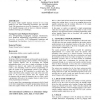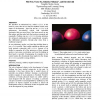5 search results - page 1 / 1 » Tangible programming elements for young children |
CHI
2002
ACM
14 years 5 months ago
2002
ACM
Tangible programming elements offer the dynamic and programmable properties of a computer without the complexity introduced by the keyboard, mouse and screen. This paper explores ...
ACMIDC
2009
13 years 8 months ago
2009
We propose simple tangible language elements for very young children to use when constructing programmes. The equivalent Turtle Talk instructions are given for comparison. Two exa...
CHI
2002
ACM
14 years 5 months ago
2002
ACM
Physical interactive environments can come in many forms: museum installations, amusement parks, experimental theaters, and more. Programming these environments has historically b...
CHI
2000
ACM
13 years 9 months ago
2000
ACM
We introduce an educational toy, called curlybot, as the basis for a new class of toys aimed at children in their early stages of development – ages four and up. curlybot is an ...
TEI
2010
ACM
13 years 11 months ago
2010
ACM
This paper describes Kinematics: a novel construction toy for children consisting of both active (shape-changing or rotating) and passive building blocks. In comparison to similar...


